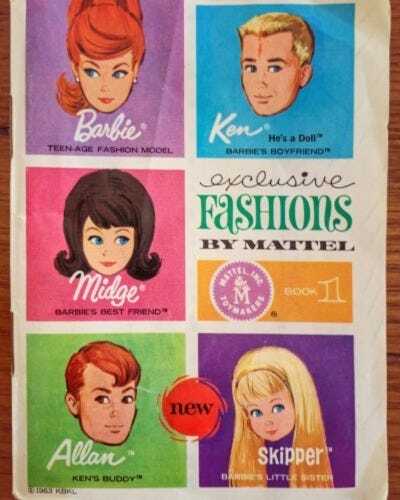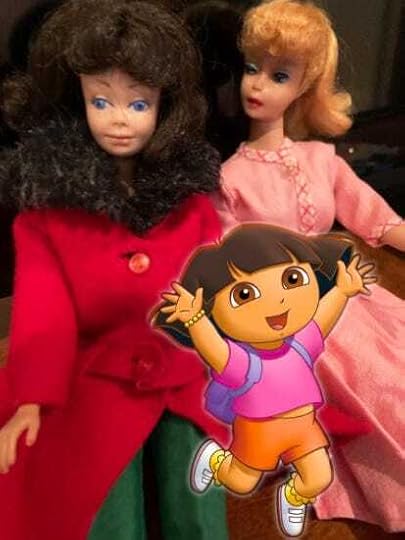Why Barbie Was Never Going to Speak to My Child
As the date to see Barbie approached, my thoughts ran wild with possible story lines and costume changes. In anticipation of our cinema girls meetup, I put on a bright pink t-shirt and opened my Barbie doll case from the 60’s. Even when we downsized, I could not find it in my heart to give it away.
Inside, Barbie, Midge and Skipper were dressed to impress. My sister and I played endless imaginary scenes in high-pitched voices, dressing and undressing Barbie and friends.
 The teeny 3" X 4" FASHIONS BY MATTEL catalog with models: Barbie, Midge, Ken, Skipper and Allan.
The teeny 3" X 4" FASHIONS BY MATTEL catalog with models: Barbie, Midge, Ken, Skipper and Allan.Midge was my favorite. Why? Because she looked like me — a brunette tomboy sporty girl — or at least I anointed her as such. Blonde Barbie was a too glamorous for my taste (too much eyeliner!).
I identified with Midge due to the one thing that I was reminded of every day of my childhood. My mother, two sisters and brother all had a major head of bright red curly hair, while my hair was straight and mousy brown, typically cut pixie style.
When we were out and about, strangers would admire, then cluck at me, “Where did you come from young lady?” If there was a five-year-old version of screw you, I would have said it.
My dad had dark brown hair, but he was never with us shopping or running errands. He was my biological link to the family and proof that I belonged.
Even good natured teasing made me feel like the odd kid out.
My own daughters had a different route to Barbie. The oldest was an only child up to the age of eight, and very assured of her place, not just in the family, but in the world. She had our undivided attention all those years and knew she could be anything that she wanted to be.
Her Barbies were purchased with a very specific relatable purpose, i.e. Baseball Barbie for the time she played in a youth softball league, etc. For the most part, Barbies stayed in the box.
My youngest daughter, adopted at age seven from Mexico, could not relate to perfection in pink. Plus, she did not look like me or her dad.
It should not have been a surprise that she refused to wear a hand me down hot pink Barbie bathing suit. She ran out of the room when I held it up before our family swim at the local pool.
All adoptions begin with the trauma of separation and loss which is referred to as the primal wound.
Who do I look like? Where did I come from?
Adopted children are grieving the family that is unknown to them.
Barbie’s career choices were not relatable at all to her. She had bigger fish to fry at that age — like learning to speak English.
Unfortunately, at the time, I was a bit clueless at all she had lost: her culture, sights, smells, food, caregivers. Toys and dolls were the least of her problems.
Barbie was never going to happen. Family survival mode kicked in and we gravitated to someone that she could relate to: Dora.
 Author’s vintage Midge and Barbie circa 1964 plus Dora
Author’s vintage Midge and Barbie circa 1964 plus DoraWhat a joy it was watching her mimic Dora and learn those first few English words.
Blended or bio, families of all shapes and sizes must be aware of the a child’s individual needs regardless of how they came to be in that family.
Here are three things that I found helpful to move my blended family forward:
Acknowledging our need to belong is critical. Where do I fit in this world? I learned to be patient and sensitive, accepting and empathetic to the emotions exhibited due to trauma: crying, anger, difficulty with relationships.Wondering about first family roots is normal and healthy even when the adopted family experience is positive and loving. The pain about the family that is unknown is constant and forever.Working through the pain is vital and means talking it out, crying it out — grief is a complicated emotion. We shared the road to our adoption story early and often with no secrets.At every opportunity, I tried to send the message: you are ours, we love you, we are here for you.
Adoptees seek a state of acceptance — not from their adoptive parents — but from themselves, their roots, their relinquishment. These are huge hurdles.
My daughter will live with her grief forever. However, loss, trauma and grief do not define her. She continues to grow stronger every day.
Anna Maria DiDio is author of the memoir Love at the Border, An Adoption Adventure, plus three adoption themed children’s books and a Philadelphia sports fan. To learn more about her writing and adoption resources visit amdidio.com. She’s on Instagram @amdidio.
[image error]Why Barbie Was Never Going to Speak to My Child was originally published in Be Yourself on Medium, where people are continuing the conversation by highlighting and responding to this story.



